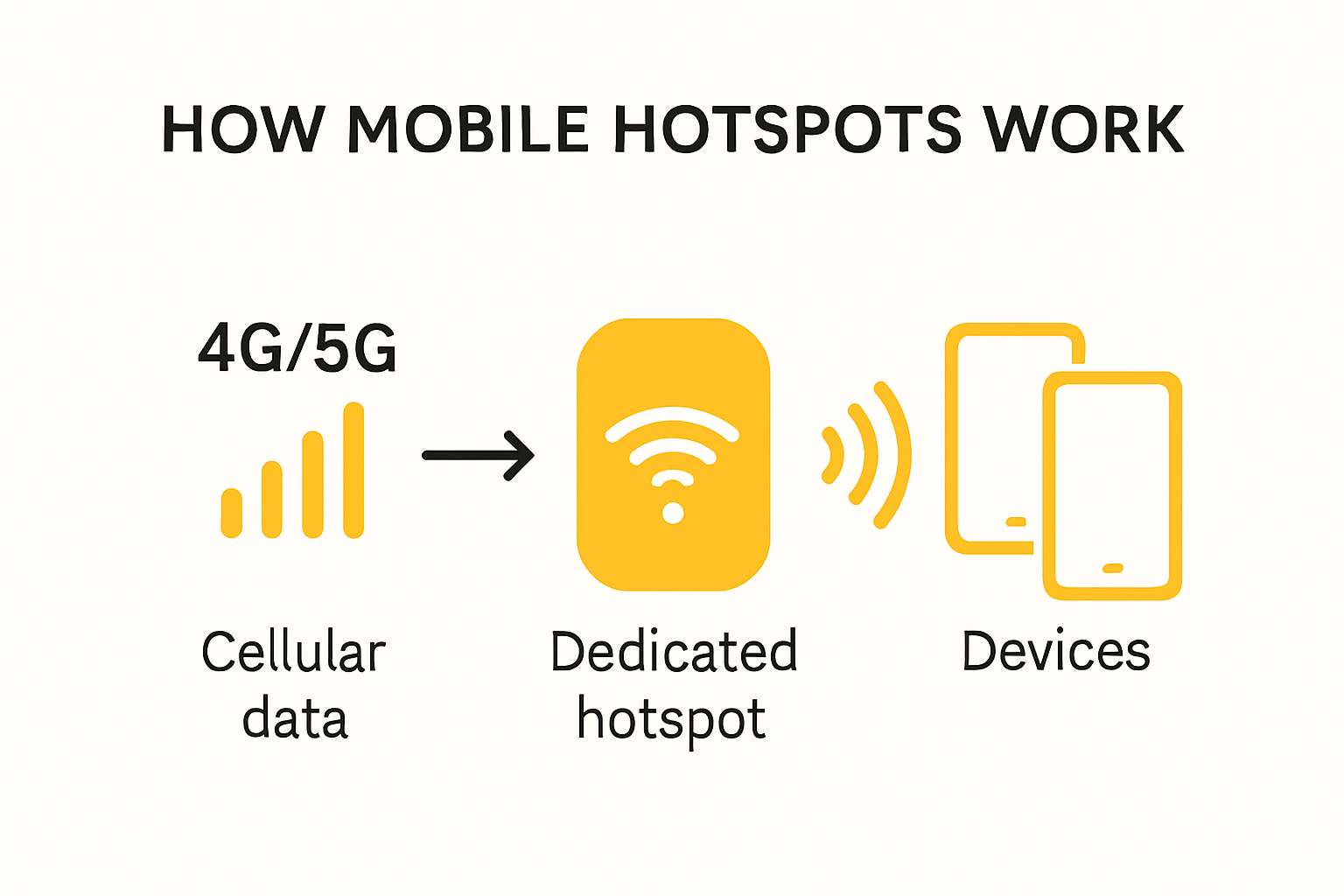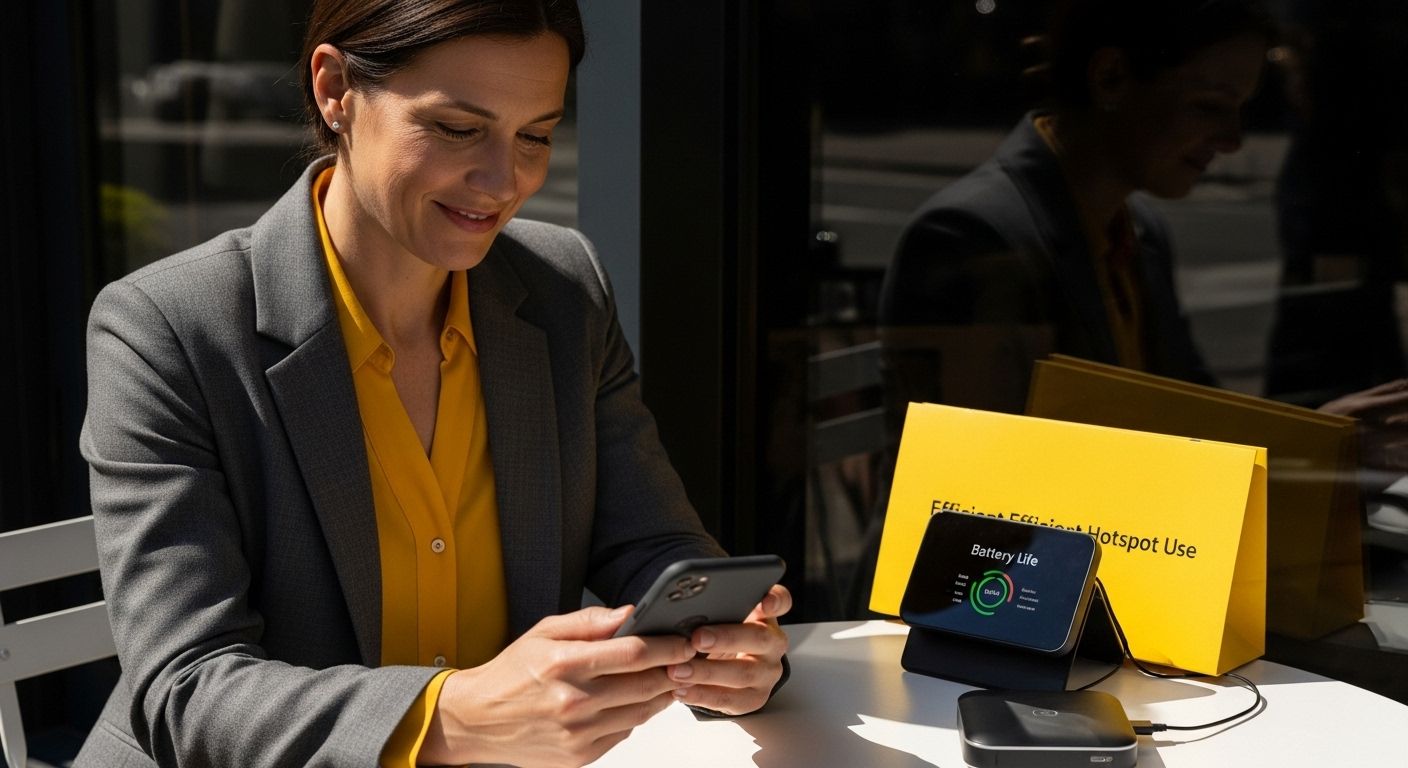
Mobile hotspots have become the lifeline for anyone wanting fast, flexible internet no matter where they are. You might think their popularity is only about easy access, but here is the shocker. A single mobile hotspot can support up to 10 devices at once while running for 10 hours on battery. That means these pocket-sized devices are turning small businesses, families, and even health appointments completely wireless in ways we never imagined.
Table of Contents
- Understanding What A Mobile Hotspot Does
- Key Benefits For Urban And Health-Conscious Users
- Choosing The Best Mobile Hotspot For Your Needs
- Top Tips For Safe And Efficient Hotspot Use
Quick Summary
| Takeaway | Explanation |
|---|---|
| Understand your data plan limits | Knowing your cellular data cap helps avoid overages and interruptions in service when using a mobile hotspot. |
| Prioritize security measures | Implement strong passwords and encryption to protect your hotspot from unauthorized access and potential cyber threats. |
| Choose the right hotspot type | Select between smartphone hotspots or dedicated devices based on your connectivity needs and frequency of use to ensure optimal performance. |
| Monitor data usage strategically | Take steps to manage data usage, such as disabling automatic updates and using data-saving modes to extend your plan’s limits. |
| Maximise battery life of devices | Use power-saving settings, keep the device charged, and disconnect inactive devices to enhance your mobile hotspot’s battery performance. |
Understanding What a Mobile Hotspot Does
Mobile hotspots have become an essential technology for staying connected in our increasingly digital world. When you need internet access on the go, these clever devices transform your cellular data connection into a portable Wi-Fi network that multiple devices can use simultaneously.
How Mobile Hotspots Actually Work
A mobile hotspot is essentially a digital bridge between your cellular network and other internet-enabled devices. According to the Federal Communications Commission, this technology allows smartphones or dedicated devices to share their cellular data connection, creating a temporary wireless network. Think of it like a digital Swiss Army knife for internet connectivity.
The process is surprisingly straightforward. When you activate a mobile hotspot, your device broadcasts a Wi-Fi signal that other devices can detect and connect to. These could include laptops, tablets, gaming consoles, or any Wi-Fi-enabled device. Each connected device then uses your cellular data plan to access the internet, effectively turning your phone or dedicated hotspot device into a portable router.
The Different Types of Mobile Hotspots
Mobile hotspots come in several varieties, each designed to suit different user needs. Smartphone Hotspots are the most common, allowing users to share their phone’s cellular data directly. Dedicated Hotspot Devices offer more robust connectivity and often have longer battery life, making them ideal for professionals or frequent travelers.
Some mobile hotspots support multiple connectivity protocols. Verizon’s technical documentation highlights that modern devices can switch between 4G and 5G networks, ensuring users have the fastest possible connection wherever they are. This flexibility means you can stay connected in urban centers, rural areas, and everywhere in between.

Key Considerations for Mobile Hotspot Users
Before diving into mobile hotspot usage, it is crucial to understand potential limitations. Most cellular plans have data caps, which means continuous hotspot use can quickly consume your monthly data allocation. Users should monitor their data usage carefully and consider plans that offer generous hotspot data allowances.
Additionally, security is paramount. Always use strong passwords for your mobile hotspot and avoid sharing the network with unknown individuals. Most modern devices offer encryption options that help protect your connection from potential unauthorized access.
Mobile hotspots represent more than just a technical convenience. They are a testament to our growing need for constant connectivity, bridging gaps between cellular networks and the myriad of devices we rely on daily. Whether you are a remote worker, a traveler, or someone who needs internet access outside traditional Wi-Fi zones, mobile hotspots offer a flexible solution to staying connected.
Remember, the key to effective mobile hotspot use is understanding your specific connectivity needs and choosing a solution that matches your lifestyle and budget.
Key Benefits for Urban and Health-Conscious Users
Mobile hotspots have emerged as a critical technology solution for urban professionals and health-conscious individuals seeking flexible, reliable connectivity. These versatile devices offer more than just internet access - they provide a lifeline of communication and convenience in an increasingly digital world.
Empowering Urban Professionals and Remote Workers
For urban professionals navigating complex work environments, mobile hotspots represent a game-changing communication tool. According to the Federal Communications Commission, mobile hotspots provide critical internet connectivity in locations with unreliable wired connections, making them essential for remote workers and digital nomads.
Urban users frequently encounter connectivity challenges - unstable home internet, limited public Wi-Fi, or the need to work from diverse locations. Mobile hotspots eliminate these barriers, allowing seamless transitions between home, coffee shops, co-working spaces, and temporary work environments. Professional Flexibility becomes a tangible reality, enabling individuals to maintain productivity regardless of their physical location.
Health-Conscious Connectivity Solutions
Health-focused users have discovered unique advantages in mobile hotspot technology. Telehealth consultations, fitness tracking, and wellness app monitoring require stable internet connections that mobile hotspots reliably provide. The American Telemedicine Association highlights how consistent internet access is crucial for remote health monitoring and virtual medical consultations.
Seniors and individuals with mobility constraints particularly benefit from these devices. They can maintain connectivity for health management apps, video consultations with healthcare providers, and staying connected with family members without depending on complex home internet setups. The Portable Health Connection offered by mobile hotspots represents more than technology - it is a lifeline of communication and medical support.
Security and Privacy Considerations
Both urban professionals and health-conscious users must prioritize digital security when using mobile hotspots. Implementing strong encryption, using virtual private networks (VPNs), and being cautious about public network usage are critical steps in protecting sensitive personal and professional information.
Modern mobile hotspot devices offer advanced security features like password protection, limited device connections, and automatic disconnection protocols. These built-in safeguards ensure that users can enjoy flexible connectivity without compromising their digital privacy.
Mobile hotspots have transcended their original purpose of simple internet sharing. They now represent sophisticated tools of empowerment, enabling urban professionals to work flexibly and health-conscious individuals to stay connected and monitored. The technology continues to evolve, promising even more integrated and secure connectivity solutions for diverse user needs.
As our world becomes increasingly digital, mobile hotspots stand as versatile companions, bridging gaps in connectivity and providing reliable internet access wherever life takes us.
Choosing the Best Mobile Hotspot for Your Needs
Selecting the right mobile hotspot requires careful consideration of your specific connectivity needs, usage patterns, and budget. Understanding the nuanced differences between available options can help you make an informed decision that maximizes your digital connectivity.
Understanding Your Connectivity Requirements
Mobile Citizen emphasizes the critical importance of assessing your specific connectivity needs before making a purchase. Consider factors like the number of devices you plan to connect, your typical data usage, and the environments where you will most frequently use the hotspot.
Key Considerations Include:
- Number of simultaneous device connections
- Average monthly data consumption
- Frequency of travel or remote work
- Budget for monthly data plans
- Performance requirements for specific tasks
According to CIO, the decision between using a smartphone hotspot or a dedicated device depends on your usage intensity. Occasional users might find smartphone hotspots sufficient, while frequent users should invest in standalone devices to preserve phone battery life and avoid exhausting their primary data plan.
Device Types and Performance Factors
Mobile hotspots come in three primary configurations: smartphone hotspots, dedicated mobile hotspot devices, and portable wireless routers. Each offers unique advantages tailored to different user needs.
Smartphone Hotspots provide convenience for occasional use, allowing you to share your phone’s cellular connection. They are ideal for users who need sporadic internet access and want to avoid carrying multiple devices.
Dedicated Mobile Hotspot Devices offer more robust performance, longer battery life, and specialized features. These devices are designed specifically for internet sharing and often provide more stable connections compared to smartphone hotspots.
The Georgia Public Library Service notes that typical WiFi hotspots can support 8-10 simultaneous users, with connection speeds varying based on cellular signal strength. This makes them versatile solutions for small groups or remote work scenarios.
To help you compare the different types of mobile hotspots discussed, the table below summarises their key features and best use cases:
| Type of Hotspot | Best For | Typical Battery Life | Number of Supported Devices | Notes |
|---|---|---|---|---|
| Smartphone Hotspot | Occasional, on-the-go users | Shorter (depends on phone) | 3-5 | Uses phone battery, easy to set up |
| Dedicated Hotspot Device | Frequent travellers, professionals | 8-10+ hours | 8-10 | Robust, longer battery, more stable |
| Portable Wireless Router | Groups, advanced users | Varies | 8-10+ | May require SIM and power source |
Evaluating Technical Specifications
When comparing mobile hotspot options, pay close attention to technical specifications that directly impact your user experience. Look for devices offering:
- Multiple network compatibility (4G/5G)
- Battery life exceeding 8-10 hours
- Secure encryption protocols
- Compatibility with your existing cellular provider
- Support for modern WiFi standards
Additionally, consider the monthly data plans offered by your cellular provider. Some plans provide more generous hotspot data allocations, while others may charge premium rates for tethering services.
Ultimately, choosing the right mobile hotspot is about finding a balance between performance, convenience, and cost. By carefully evaluating your specific needs and understanding the available technologies, you can select a solution that seamlessly integrates into your digital lifestyle.
Remember that technology evolves rapidly, so what works best today might change in the near future. Stay informed about emerging connectivity solutions and be prepared to adapt your mobile hotspot strategy as new technologies emerge.
Top Tips for Safe and Efficient Hotspot Use
Mobile hotspots have become an essential tool for staying connected, but using them effectively requires understanding both security and performance best practices. Implementing strategic approaches can help you maximize your mobile hotspot experience while protecting your digital information.
Securing Your Mobile Hotspot Connection
The Federal Communications Commission emphasizes the critical importance of network security when using mobile hotspots. Encryption is your first line of defense against potential digital threats.
Key security strategies include:
- Always use WPA2 encryption for your mobile hotspot
- Create a strong, unique password that combines letters, numbers, and special characters
- Regularly update your device’s firmware and security settings
- Limit the number of devices connected to your hotspot
The University of Michigan recommends using a Virtual Private Network (VPN) when connecting to mobile hotspots. A VPN encrypts your internet traffic, creating an additional layer of protection against potential cyber threats and unauthorized access.
The table below provides an easy-to-follow checklist of key security and performance steps to ensure safe and efficient hotspot use:
| Tip or Step | Category | Why It Matters |
|---|---|---|
| Use WPA2 encryption | Security | Protects your network from unauthorised access |
| Set a strong, unique password | Security | Reduces risk of hacking and password guessing |
| Regularly update firmware/settings | Security | Ensures the latest bug fixes and security enhancements |
| Limit number of connected devices | Security | Reduces risk of security breaches and speeds up network |
| Use a VPN | Security | Adds an extra layer of protection for sensitive data |
| Disable automatic device updates | Performance | Prevents unwanted data usage spikes |
| Use data-saving modes | Performance | Extends your available data and plan limits |
| Monitor data usage regularly | Performance | Avoids surprise overages and throttling |
| Keep hotspot charged and use power-saving modes | Maintenance | Ensures uninterrupted access while travelling |
Optimizing Performance and Data Management
FedTech Magazine highlights the importance of strategic data usage. Mobile hotspots operate on cellular data plans, which means monitoring and managing your data consumption is crucial.
Performance Optimization Techniques:
- Disable automatic updates on connected devices
- Use data-saving modes on smartphones and laptops
- Avoid streaming high-definition video or large file downloads
- Close background applications that consume data
- Monitor your data usage through your device or carrier app
Consider setting up data usage alerts to prevent unexpected overages. Many cellular providers offer tools that track your data consumption in real-time, helping you stay within your plan’s limits.
Battery Life and Technical Maintenance
Mobile hotspots rely on battery power, making battery management a critical aspect of efficient use. To maximize battery life and device performance:
- Keep your mobile hotspot device charged
- Use power-saving modes when possible
- Avoid exposing the device to extreme temperatures
- Carry a portable battery pack for extended use
- Disconnect devices when not in active use
Regularly restart your mobile hotspot to clear temporary cache and refresh the connection. This simple step can help maintain optimal performance and resolve minor connectivity issues.
While mobile hotspots offer incredible convenience, responsible use requires a proactive approach to security and performance. By implementing these strategies, you can enjoy flexible, secure internet connectivity wherever your digital life takes you.
Remember, technology evolves rapidly. Stay informed about the latest security practices and mobile connectivity solutions to ensure you are always getting the most from your mobile hotspot experience.

Frequently Asked Questions
What is a mobile hotspot?
A mobile hotspot is a device that uses cellular data to create a portable Wi-Fi network, allowing multiple devices to connect to the internet wirelessly.
How does a mobile hotspot work?
Mobile hotspots work by connecting to a cellular network and then broadcasting the internet connection as a Wi-Fi signal that other devices, like laptops or tablets, can connect to.
What are the main types of mobile hotspots?
The main types of mobile hotspots include smartphone hotspots, which share a phone’s cellular data, and dedicated hotspot devices, which provide a separate connection specifically for internet sharing with often better battery life and performance.
What should I consider when choosing a mobile hotspot?
When choosing a mobile hotspot, consider factors such as the number of devices you need to connect, your data usage habits, battery life, and whether you need 4G or 5G connectivity.
Ready to Power Up Your Mobile Life? Discover Solutions You Can Trust
If you have been learning about mobile hotspots, you know how vital secure, flexible connectivity is for modern life in South Africa. Maybe you are frustrated by battery issues, hungry devices draining your data plan, or having to juggle multiple tech accessories when you travel. The article highlights key pain points like unstable connections, managing several devices, and the constant search for reliable, affordable tech. The right tools are essential for keeping your portable Wi-Fi network strong and secure. But getting those tools can feel overwhelming in a market full of choices that do not always deliver.
This is why PMC Jewellery’s Best Selling Tech is your next step. We have transformed into the Smart Choice Marketplace where you will find top-rated mobile accessories, wireless essentials, smart wearables, and consumer electronics all in one place. Every item is backed by local support and real-time tracking, so you stay connected whether at home, at work, or on the move. Take action today and explore our latest collection for unbeatable deals on the tech you need right now. Shop with confidence at PMC Jewellery and keep your devices and connections one step ahead.
Recommended
- For Samsung Gear Sport 20mm Carbon Fiber Striped Silicone Watch Band(Y – PMC Jewellery
- For Samsung Galaxy Watch 5 44mm 20mm Two-color Stripe Silicone Watch B – PMC Jewellery
- For Samsung Galaxy Watch 46mm / Gear S3 Universal Sports Two-tone Sili – PMC Jewellery
- Nylon Watch Band For Apple Watch Series 7 45mm / 6 & SE & 5 & 4 44mm / – PMC Jewellery
